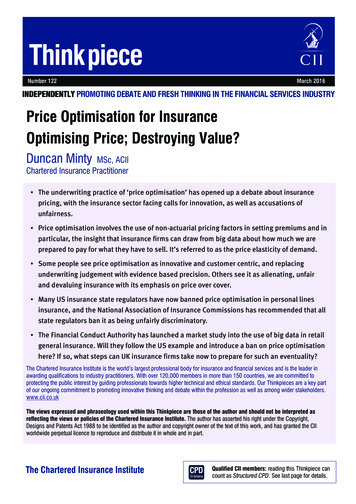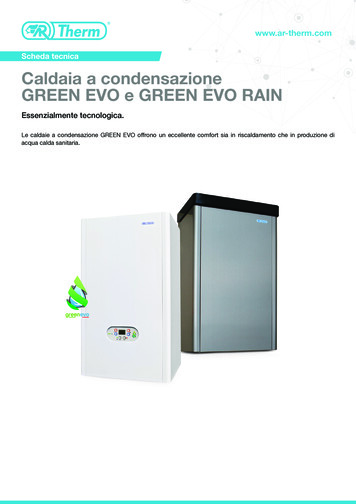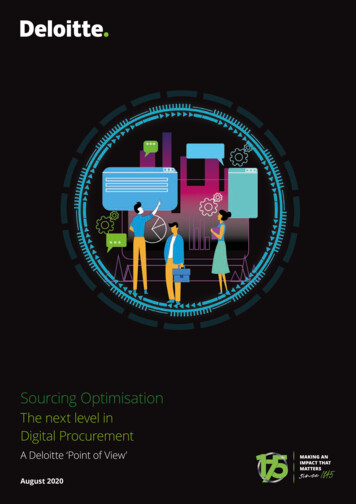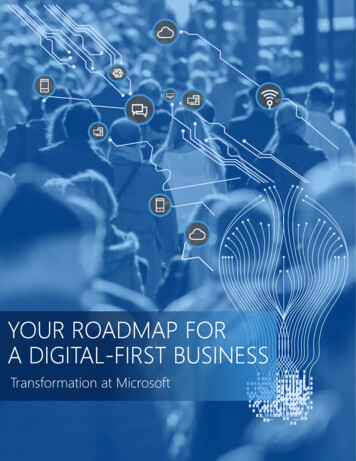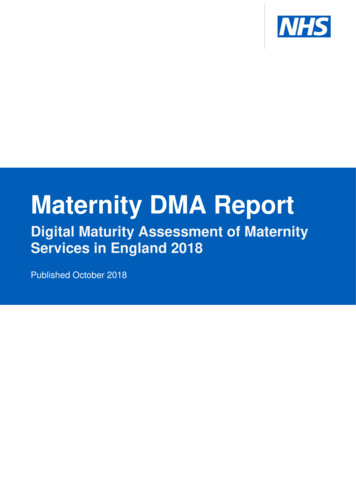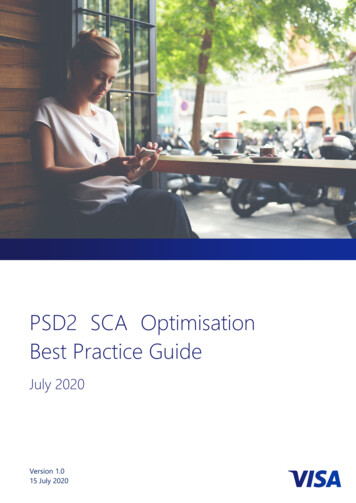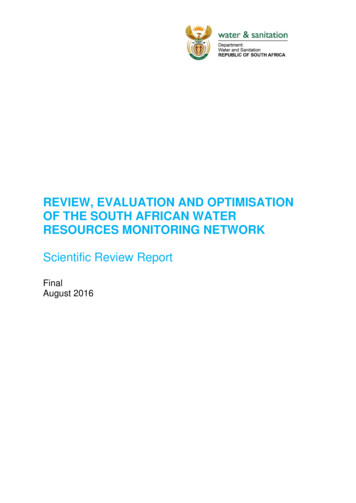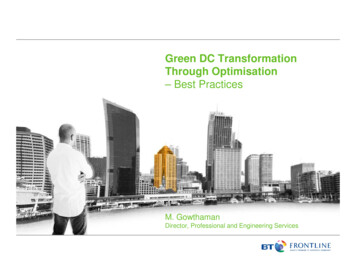
Transcription
Green DC TransformationThrough Optimisation– Best PracticesM. GowthamanDirector, Professional and Engineering Services
Green DC Transformation through OptimisationAgenda Green DC Transformation – Business Drivers Green DC Transformation – Technologies DC Consolidation / Virtualisation Methodologies Managing the Consolidated DC
Green DC Transformation: Business DriversMarket Trends– Reduced time to market– Demand for greater business flexibility– Rising cost of platforms– Drive for operational efficiencies– Core versus context (smart-sourcing is a key trend)– IT optimisation is now a business process enabler
Green DC Transformation: Business DriversCustomer Challenges– Complex infrastructure: too much infrastructure, poorlyutilised, varying standards– High value problems: legacy platforms, high costs,specialised resources– Business strategy: leveraging infrastructure forbusiness change– Innovation: willingness to do things differently to achievebusiness objectives– Move away from Victorian engineering principles:designing systems not to the maximum but on demand
Green DC Transformation: Business DriversConcerns that CIOs have about IT needsManaging theincreasingcost of energyMinimisingloss ofenergy andROIRunningout ofpowerRunningout ofspaceAchieving businesssustainabilityRunningout ofcoolingAdhering toenvironmentallaws andimproving thecompany image
Green DC Transformation: Business DriversWhy Need a Green Data Centre Data centres consume 1.5% of all electricity in 2006 and growingat 12% annually– Department of Energy– If IT were an industry, it would be approaching the top five energyconsumersData centres forecasted to surpass airlines in terms of CO2emissions by 2020 due to energy consumed – McKinsey & Co. 2008– Can you say “threat of regulation”?Data centre power demands have doubled in last five years and76% growth is predicted between 2005 and 2010 – IDCThree year cost of powering and cooling a typical server is now1.5x the purchase cost of the hardware – Uptime Institute 2007Energy costs are 15-20% of IT’s operating expenses – Dave Ohara,Microsoft 200750% of data centres will have insufficient power and coolingcapacity by 2008 – Gartner 200670% of Global 1000 will need to significantly change their datacentres in the next five years to meet current and future energyneeds – Gartner 2007
Green DC Transformation through OptimisationWhat can I do?Who can help?Unuseful redundancies?Silos?Billing?Utilisation rate?Usage resource monitoring?Virtualisation?Energy efficient hardware?Local cooling?IT equipmentHumidity?Heat removal?Power/performance oriented?FacilitiesPower Monitoring?How is energy used?Lighting?Which type of equipment?Capping?How is billing done?Thermal monitoring?Old, expensive?Consolidation?DCiE?Location?Data centre assessment: Ask effective questionsWhich tier am I?Air flow?Space?Power distribution?Water cooling?
Green DC Transformation through Optimisation– Solution DefinedSolutionDesign, Build and Manage Consolidated / VirtualisedGREEN DCDC FacilityInfrastructureDC ITInfrastructure
Green DC Transformation through OptimisationGreen Data Centre – DefinedA green data centre is defined as adata centre in which the mechanical,lighting, electrical and computersystems are designed for maximumenergy efficiency and minimumenvironmental impact.
Green DC Transformation through OptimisationJourney towards the Green data centreIT Infrastructure EnergyEfficiency StrategyConsolidate manycentres into fewerReduce infrastructurecomplexityImprove facilitiesmanagementReduce stuffingrequirementsImprove businessresilience (managefewer things better)Improve operationalcostsMigrate many applications into fewerimagesRemove physicalresourceboundariesSimplify IT environmentIncrease a hardwareutilisationConsolidate manyservers into fewer onphysical resourceboundariesReduce systemmanagementcomplexityReduce ionImprovedOperationsReduce operations resourcesImprove application specificmonitoring an tuningAllocate less thanphysical boundaryReduce lisationState-ofthe-ArtBestPracticesIntegrated powermanagementDirect liquid coolingCombined heat and powerHot and cold aislesImproved efficiency transformers, UPS, chillers,fans, and pumpsFree coolingFlywheel technologyConservation techniquesInfrastructure energy efficiencyImproved airflow managementFacility InfrastructureEnergy EfficiencyStrategy
Green DC Transformation through OptimisationVirtualisation in Perspective Virtualisation is the ability to create logical abstraction ofphysical assets. In the case of server virtualisation, it allowsfor multiple “virtual” servers to run on one physical server,thereby consolidating many physical servers onto one. Reducing the number of physical components that provide aservice Reducing cost and improving the quality of service Standardising the operating environment
Green DC Transformation through OptimisationBenefits of Virtualisation Maximise server utilisation Less physical servers– Lower maintenance– Accommodation and environmental savings (space, power,A/C, lighting) Improve deployment time quicker to market Reduce manpower overheads Simplify centralised management Future proof technology Seamless server upgrade path and transportable servertechnology (VMOTION) Help to benefit disaster recovery, backups and rapiddevelopment with snapshot and rollback features Increase server availability, no single point of failure,minimise downtime Reduce TCO
Green DC Transformation: Technologies Storage Virtualisation– Storage virtualisation applies an abstraction to the storage systems withinthe enterprise and is often a key component used with blade systems.Virtualising the storage allows storage virtual disks to be defined tocomponents running on the server and separates the physical managementand sometimes connection of those disks from the application software onthe server. I/O Virtualisation– I/O virtualisation is similar to network virtualisation. It abstracts the I/Ointerface away from the blade Network Virtualisation– Abstraction layer is applied to the networking components to provide betterservice, availability, and security to the physical servers and theirapplications– Implementation at switch level, NIC card or in software (e.g VLAN, loadbalancer where sender does not know actual address) I/O Virtualisation– I/O virtualisation is similar to network virtualisation. It abstracts the I/Ointerface away from the blade (e.g. Egenera pBlades and cBlades)
Green DC Transformation: TechnologiesVirtualisation Models for Servers Below Kernel– Happens below the OS, which may not even be aware thatvirtualisation is happening– Modus operandi of hypervisor-based virtualisation technologies– Common type of virtualisation– Pros: Transparency of strategic perspective, as applicationrunning in VMs get their own OS – hence look and like as itwas before virtualisation– Cons: Virtualisation layer overhead as it intercepts operationsintended for hardware components Overcome by a techniques “Par Virtualization” by makingthe OS aware that it has been virtualised – allowing toaccount for this in its operation and avoid unnecessaryoverhead
Green DC Transformation: TechnologiesVirtualisation Models for Servers (cont’d) Above Kernel– Isolation of applications from within the OS, segregating andcontaining them from one another executing within the sameOS kernel - Containers, Jails, Zones, Workload Partitions– Pros: Efficiency gained through economies of scale Allows the apps to communicate directly with devicedrivers, avoiding overhead– Cons: Single patch may affect many running applications Level of separation may not be sufficient for certainenvironment
Green DC Transformation: MethodologiesDC Consolidation / Virtualisation MethodologyPhase IPhase IIPhase IIIPhase IV & ySecurityArchitectureSecurityTransfer ofKnowledgeInfrastructureInfrastructureData Centre Consolidation ProcessCompletion ofProject
Green DC Transformation: Methodologies Business Objectives– Establishing business justification for consolidation ofservers– Reduce TCO– Improve service levels– Provide increased application availability– Increase the manageability of the information technology(IT) environment Business benefits––––Reducing IT costsKeeping up with business challengesImproving service levels and availabilityMinimising the impact of external pressures
Green DC Transformation: Methodologies Avoiding Common Pitfalls and Failures–––––––Convince business units to surrender serversGain and maintain executive sponsorshipManage politicsApply best practices and adhere to standardsDevelop and adhere to well-defined processesRely on established consolidation methodologiesConsider prohibitive bandwidth costs of high data-trafficapplications– Select appropriate applications to consolidate together– Identify application or middleware coexistence problems– Consider legal requirements to keep data locally
Green DC Transformation: MethodologiesStep 1 – Assessing the Technical Feasibility Feasibility– Conduct an interactive workshop with customer’s managementand IT admin teams– Gather information on business requirements and objectivesand the desired technical objectives– Define the business objectives for consolidation/virtualisationand expected results of the project– Estimate the expected reduction in TCO and the expected ROI– Feasibility report on consolidation for management’s decisionmaking
Green DC Transformation: MethodologiesStep 1 – Assessing the Technical Feasibility (cont’d) Assessment––––––––Assess Application RequirementsInterviewing application owners and maintainersDescribing major software componentsCreating a flowchart of network inputs and outputsDescribing an operational scheduleIdentifying and describing important dependenciesCreating a road map for the future growth of the applicationDuring this assessment, we will document all of the variousaspects of the application.
Green DC Transformation: MethodologiesStep 1 – Assessing the Technical Feasibility (cont’d) Assess Platform Requirements––––Deploying tools to assess the followingVerifying inventoriesAssessing technical configurationsGathering server utilisation statistics Assess Storage Requirements– Corporate standards, and storage architecture road map &Capacity Plan– Online storage of applications and data– Offline storage for backup Assess Networking Requirements– During assessment we will examine the following: Assess the topology and technologies utilised for thenetwork. Assess throughput, bandwidth, and latency (for eachserver involved in the consolidation)
Green DC Transformation: Methodologies
Green DC Transformation: MethodologiesStep 1 – Assessing the Technical Feasibility (cont’d) Assess Security Requirements–––––Assessment will focus on the following four major areas:Security operationsSecurity policy and standardsSecurity proceduresSecurity implementation
Green DC Transformation: MethodologiesStep 1 – Feasibility and Assessment Phase:Deliverables Management SummaryBusiness ObjectivesCriteria for SuccessTCO Assessment Details– Other assumptions– Assessing apps profiling, platforms, storage, network, security,infrastructure and ops, assessing risks– Scenarios (e.g 40% reduction in server/storage)– ROI analysis (Scenario 1 or 2) Conclusions
Green DC Transformation: MethodologiesStep 2 – Designing a Consolidated Architecture Technical Constraint Analysis– Server Analysis– Storage Analysis– Network Analysis Business Constraint Analysis– Business Constraints– Process Constraints– Security Constraints
Green DC Transformation: MethodologiesStep 2 – Designing a Consolidated Architecture(cont’d) Workload Constraint Analysis––––––CPU AnalysisMemory AnalysisDisk AnalysisNetwork AnalysisAggregate Utilisation AnalysisPower Consumption Analysis Combining All Constraints: Comprehensive Analysis– Net-effect view of constraints– Permutation-based optimisation What-If Analysis– Exploring Technical Options– Exploring Business Options
Green DC Transformation: Methodologies
Green DC Transformation: MethodologiesStep 2 – Designing a Consolidated Architecture:Deliverables Consolidated/Virtualised Architecture Report– Detailed apps, platform, storage, network, security and DCfacilities with assumptions on sizing and capacity planning withdetailed calculations– Walkthrough the Design with the customer’s steering committeeproject team– Highlights on risk in implementation and mitigation process
Green DC Transformation: MethodologiesStep 3 – Implementing a Consolidation Solution Preparing for the consolidation––––Creating a build specificationBuilding the environmentDefining your migration strategyPracticing the consolidation Implementing the Consolidation–––––Migrating applicationsTesting the configurationTuning the configurationDocumenting the results of the configurationTraining the administrative staff
Green DC Transformation: MethodologiesStep 3 – Implementing a Consolidation Solution:Deliverables Handover the consolidated working DC with the followingdocuments– Design specification and configuration docs– Checklist to verify the business objective met– Train the operations staff on the implemented systems Tools and Specification: TIA 942 specs for DC facility andbest practices from Principal vendors
Green DC Transformation: MethodologiesStep 4 – Managing Consolidated EnvironmentBusiness ValueEnterpriseArchSOA/ILMDemandIT GovernanceStrategic IT Planning & OrganisationITILApplicationsIT Service& ntArchitecture &DesignInfrastructureIntegrationAcquisition astructureManagementServiceDeliveryServiceSupport
Questions and Answers
VMware Managementwith FoglightUnlock a New View on Application Management Managing the Impact of VMware on Applications and End UsersMark TritarisOctober 22, 2008 2008 Quest Software, Inc. ALL RIGHTS RESERVED.
Change DriverContinuous change is inevitable and driven from the top bythe need to improve results across the organization.
Foglight Application and Services ManagementQuest is the only provider of adaptive application and servicesmanagement to connect:Business Services to InfrastructureEnd User to DatabaseProduction to Developmentto unify IT and the business.
Fundamental ChallengeUnderstanding the impact of resource sharingCPUNetworkMulti-Core ProcessorsShared ConnectivityLoad BalancingMemorySharingOver-commitmentCore 4ResourcesRedundancyDiskShared storageFiber, iSCSI, NAS
ClarityTo see what you need to quickly and easily Existing tools show data in manytabs Alarming is simplistic and doesn’tshow trends Management frameworks requiremultiple management servers– Administering servers independently– Missing “single pane of glass”virtualization data views– Struggling to compare metrics, virtualinfrastructure layers
ExpertiseTo manage new and different technology No context around virtualizationmetrics Expert advice not given Virtual machine metricsinaccurate– Hypervisor has dynamicresource scheduling– Live migrations toalternate hardware– Timekeeping issuesinside virtual machines
ContainmentOf alarm storms and information overload Host issues could impact virtualmachines Host issues alarm when issuedetected Each VM on host raises its ownalarm One single issue canescalate to many– Complicates root-causeanalysis and resolution– Makes problem appearmore significant that it is
Asset TrackingTo know what happened and why VMs moving across hosts due toVMotion, DRS, HA Could move to more/lesspowerful systems May impact overall VMperformance Migrations impact share poolsand allocations Need to track migrations toassist with root cause analysis Impact analysis prior tomigration
PreventionOf future problems Impact analysis prior tomigration– For all “Core 4 Resources”– Understand growth trends Ensure service levels aremaintained Understand “Best Practice”configurations and patterns Starting to move toward the fluiddatacenter– Predictive– Automated
SummaryAddressing the Challenges of Monitoring a Virtual ention
VMware Management with FoglightSolution Overview Foglight helps organizationsunderstand the entire virtualinfrastructure Manages relationships andinteractions between all thecomponents in the virtualinfrastructure:––––––Data centersData storesClustersResource poolsESX serversVirtual machines
Foglight Complements VirtualCenterVMware VirtualCenter Ideal for configuration and administration Helpful when laying out the virtual infrastructureFoglight for VMware Ideal for managing performance and availability Helpful to visualize and understand the virtualenvironment and how it affects applications
VMware Management with FoglightKey Capabilities Role-based Views Out-of-the-Box Alerts withExpert Advice Asset and ConfigurationTracking Workload Migration Modeling Service Level Management Resource UtilizationManagement Multiple Virtual CenterManagement Reporting
Role-Based ViewsKey Capabilities Summary Single view of all Alarms in Datacenterby Infrastructure level or severity Single view of key performancemetrics aggregated at Datacenter level CPU (%Ready / % Used) Network I/O Disk I/O Memory Summary View of Datacenter objects Resource Pools Hosts VMs Unique Drill-Down ability to quicklyisolate issues
Out-of-the-Box Alerts with Expert AdviceKey Capabilities Summary Detailed analysis and expert advice Understand where the incident isoccurring ESX Server Virtual Image Operation System Out-of-the-box expert advice surely allows you toreview data on how to resolve the problemeffectively
Asset and Configuration TrackingKey Capabilities SummaryAsset Tracking Tracks the movement of virtual machines from onephysical server to anotherMigration Modeler allows you to understand the impactthat a virtual machine will have on the physical server
Workload Migration ModelingKey Capabilities Summary Show the impact of moving avirtual machine from onephysical system to another Determine if planned moveswill have unfavorable impacton: Resources Applications End users
Service Level ManagementKey Capabilities Summary Structure services as KPIs,SLOs or OLAs Determine SLA compliancethrough: Service windows Role of userinvestigating theservice Performance andavailability data Service desk metricsand custom logic Measure service levels forbusiness-criticalapplications that leverage avirtual infrastructure
Resource Utilization ManagementKey Capabilities Summary Network summary Network throughput Current send/receive data Per HostPer NIC Data store summary Capacity Used space vs. free space Growth rate Estimated time until full
Multiple VirtualCenter ManagementKey Capabilities SummaryVMware Virtual Infrastructure 3 (VI3)Web-BasedInterfaceFoglight forVMwareVMwareVirtualCenterManagementServerSingle VirtualCenterImplementation
Multiple VirtualCenter Management (CONTINUED)Key Capabilities SummaryVMware Virtual Infrastructure 3 (VI3)Web-BasedInterfaceVMware VirtualCenterManagement Server (1)Foglight le VirtualCenterImplementationVMware VirtualCenterManagement Server (2)VMware VirtualCenterManagement Server (N)
ReportingKey Capabilities Summary Out-of-the-box reports to helpyou understand: Individual virtual images Physical servers Resource groups Virtual asset tracking Resource allocationchanges Virtual infrastructureevents Examine performance in realtime Correct resource imbalances Analyze historical data to assessusage over time
VMware Management with FoglightKey Benefits Understand how the virtual environment impacts theapplication Quickly determine the root-cause of an incident orproblem Contain alarm storms from virtual machines andphysical servers Track movement of virtual machines and understandtheir impact Identify contention for resources between virtualmachines
Application Transaction monitoring and correlation from end user to database Service level monitoring and correlation from business services toInfrastructure componentJava.NET Application dependency mappingSiebel PSFT Detect, diagnose and resolve issues quicklyOEBSAPEnd UserService Levels Synthetic user performance analytics Real user performance analytics Real user session analytics Cross domain service modeling Role-based dashboards Service chain discovery and mapping Prioritize problems based on business impactApacheMicrosoft IISCitrixRich clientsDatabaseInfrastructure OS MonitoringNetwork Device ManagementMiddleware ManagementVirtualization ManagementIntegrate with existing monitoring assetsWindowsSolarisHP/UXMQVMwareSUSERedhatAIX Monitoring Diagnostics Past and Present Analytics SQL Optimization Database ‘Defrag’/Reorg Toad Development/AdminOracleSybaseSQL ServerDB2 UDB
What’s Next? Foglight Application & Service Management:http://www.quest.com/application-and service-management/ Foglight VMWARE Application rvice-managementtechnology/vmware.aspx Feature Whitepaper: Five Ways to Ensure Your Virtualization InitiativesEffectively Support Applications and End managementtechnology/vmware.aspxCheck out our Demo Booth at VMWARE Vforum!
Thank You 2008 Quest Software, Inc. ALL RIGHTS RESERVED.
Green DC Transformation: Business Drivers Customer Challenges - Complex infrastructure: too much infrastructure, poorly utilised, varying standards - High value problems: legacy platforms, high costs, specialised resources - Business strategy: leveraging infrastructure for business change - Innovation: willingness to do things differently to achieve .
